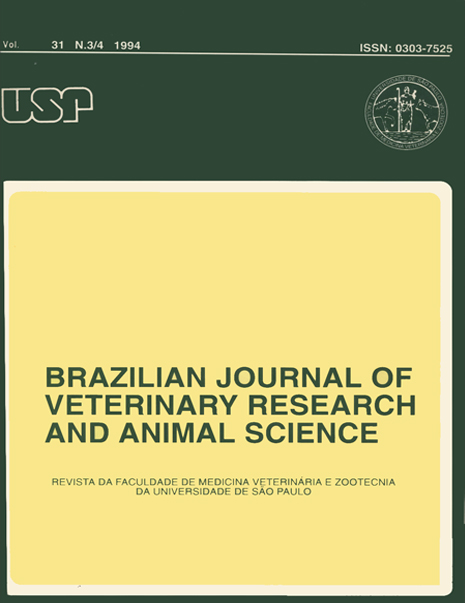Effect of follicle stimulating hormone (FSH) and human menopausal gonadotrophin (hMG) as superovulating agents in consecutive treatments of holstein black and white cows used in embryo transfer
DOI:
https://doi.org/10.11606/issn.1678-4456.bjvras.1994.52079Keywords:
Superovulation, FSH, Embryos, Pregnancy (diagnosis), Cows (Holstein), Embryo transferAbstract
Ten Holstein cows were used as embryo donors in an experiment to compare two superovulatory hormones: FSH (38mg) and hMG (2.400 U.I. = 1.200 U.I. FSH + 1.200 U.I. LH), in decreasing twice daily doses, for 4 days following day 10th of the estrous cycle. On 3rd day after treatments had started, prostaglandin F2 alfa (500µg) was applied for synchronization of oestrus. A.I. was performed 12 and 24 hours after first signs of oestrus. Same procedure was repeated for 5 times, with 60 days interval, in the same cows, to verify possible changes in superovulatory response. Embryos were recovered by non surgical procedure on 7th day after oestrus, through a Neustadt Ad-Aisch catheter. Each uterine horn was washed with 500 ml of modified Dulbecco’s medium plus 1% fetal bovine serum. Recovered medium was allowed to rest during half an hour, then supernatant was siphoned. Detailed examination of the embryos was performed in remaining 100 ml medium, with a stereomicroscope (10 to 40 x magnification). From 105 structures obtained with FSH and 43 obtained with hMG, 79 (75%) and 31 (72%) embryos were able, respectively, for transfer to uterine horn ipsilaterally to corpora lutea, also through non surgical procedure. Pregnancy diagnosis was performed by rectal palpation 45-60 days after embryo transfers. The pregnancy rates were 43% (34/79) for FSH treatment and 55% (17/31) for hMG treatment.
Downloads
Downloads
Published
Issue
Section
License
The journal content is authorized under the Creative Commons BY-NC-SA license (summary of the license: https://





